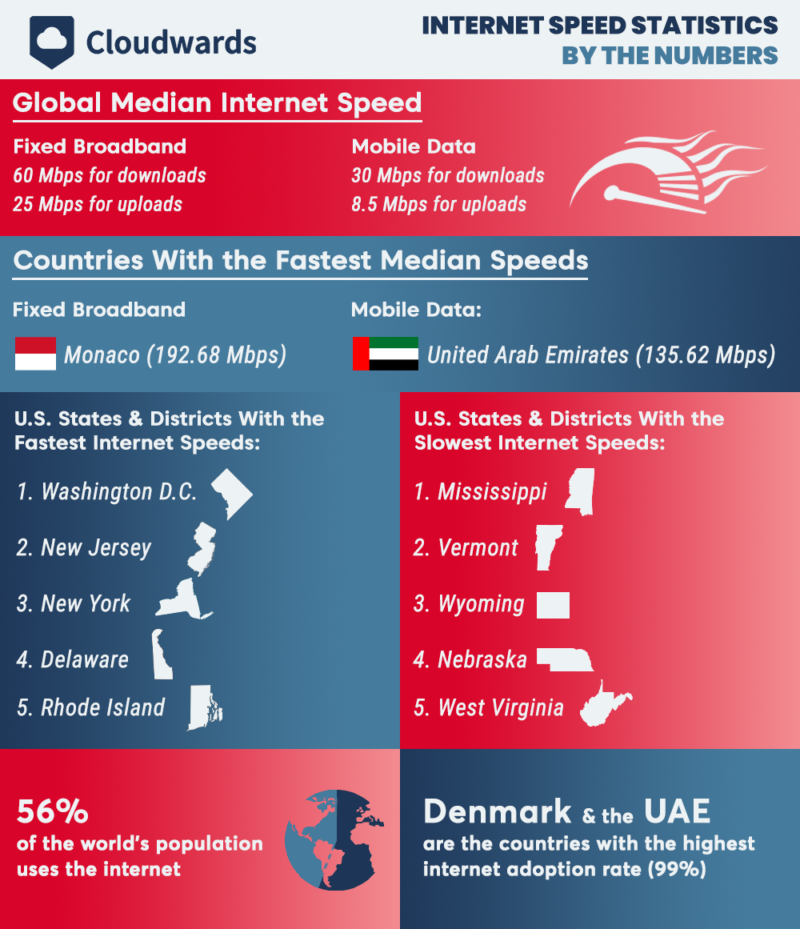14 Internet Speed Statistics, Facts & Trends for 2025
Finding consistent and accurate data about internet speed statistics and trends around the world can be incredibly difficult, especially if you’re looking for the complete picture rather than information on a single country or region. Keep reading to learn all about the future of internet speed.
Despite how crucial the internet has become to modern life, there are still plenty of people who either have no access to it or deal with glacial speeds. We’ve gathered 14 of the most interesting internet speed statistics, as well as trends relating to availability and technology types, for you to get the best picture possible of the state of the internet.
Key Takeaways:
- Internet speeds are increasing rapidly across the world, especially in wealthier countries.
- Hundreds of millions of internet users are added globally each year, with a majority of the world population now online.
- There is still a significant disparity in internet speed and availability between low- and high-income countries.
If these stats pique your interest, make sure to check out some of the other entries in this series, such as online shopping, remote work and cybersecurity statistics. For now though, let’s start breaking down the facts on internet speed and availability.

Internet Use & Internet Speed Statistics: Quick Look
If you’re just looking for the juiciest stats and don’t want to scroll through the entire article, here are a couple of the most notable ones about internet speeds and use.
- Since 2019, a majority of the world’s population has had access to the internet.
- The rate of internet adoption varies year by year, but new internet users number in the hundreds of millions yearly.
- The U.S. has the most widely available 5G mobile network, closely followed by the Netherlands.
- Fixed broadband connections are generally faster than mobile networks in most regions, with the exception of Africa.
Clearly, there are a lot of interesting aspects to the development of internet infrastructure across the world. Now that we’ve given you a small taste, let’s dive into our full list of statistics, facts and trends.
14 Internet Speed Statistics, Facts and Trends
We’ve grouped these statistics into three categories. We’ll start by looking at facts relating directly to internet speed, move to availability trends, then end with statistics related to the types of high-speed internet that exist.
Internet Speed Across the World: Speeds by Country
Let’s get the ball rolling by taking a look at the statistics you’re probably the most interested in: those relating to internet speeds around the world.
1. What Is the Global Average Internet Speed?
The global median internet speed in December 2021 was around 60 Mbps for download speed and 25 Mbps for upload speeds, according to Ookla, which operates the most popular speed testing tool in the world.
This only accounts for fixed broadband connections, though, as mobile networks are much slower on average, clocking median speeds of 30 Mbps download speed and 8.5 Mbps upload speed.1
2. How Fast Is the Average Download Speed Increasing Globally?
Global internet speeds increased rapidly during the past few years. In a July 2021 update, Ookla estimated that since 2017, the global average speed rose by 31.9% each year for fixed broadband and 59.5% for mobile networks.3
3. What Country Has the Fastest Fixed Internet?
Monaco has the fastest median speed for fixed broadband connections at 192.68 Mbps.1
4. What Countries Have the Fastest Mobile Data?
If you go by the median speed, the United Arab Emirates has the fastest mobile data network with a median average of 135.62 Mbps.1
5. Where are Internet Speeds Getting Faster?
For fixed broadband, Asia and South America outpace every other region by far, with a 51.8% and 60.9% increase, respectively, between 2018 and 2019.
For mobile networks, Asia again topped the list at 27.2%, but North America was close behind at 25.4%.10
6. What U.S. State Has the Fastest Internet?
Though not technically a state, Washington D.C. has the highest median internet speed in the U.S. at almost exactly 100 Mbps download speed and 15 Mbps upload speed.
Among actual states, New Jersey has the fastest internet speeds, coming in first with 73.69 Mbps and 12.65 Mbps in download speeds and upload speeds, respectively.
Overall, Northeastern states have a significant lead over other parts of the country, with the top five states/districts having the fastest internet speeds being: Washington D.C., New Jersey, New York, Delaware and Rhode Island.6
7. What U.S. State Has the Slowest Internet?
The slowest median internet in the U.S. is in Mississippi, at 28.05 Mbps for download speed and 4.74 Mbps for upload speed.
There is little regional consistency, though, as the bottom five states are all relatively far apart: Mississippi, Vermont, Wyoming, Nebraska and West Virginia.6
Internet Availability Trends & Statistics
Fast internet is great, but it doesn’t do much good if it’s not widely available. Next, we’ll go through a few interesting statistics relating to the availability of high-speed internet around the world.
8. How Many People Have Access to the Internet Globally?
According to the World Bank, 2019 was the first year in which more than half of the world’s population was estimated to have access to the internet, with internet users making up 56.72% of the world’s population.
However, there is significant inequality in internet access. The World Bank estimates that 89% of inhabitants of high-income countries had access to the internet in 2019, but only 53% in middle-income countries and 41% in lower-middle-income countries had access in the same year.
There was no data for low-income countries in 2019, but only 14% of people in low-income countries had internet access in 2017.7
Percentage of World Internet Users
9. How Many New Internet Users are Added Each Year?
For new internet users, 330 million new internet users were added between April 2020 and April 2021, according to the Global Statshot Report from DataReportal. This represents a year-over-year growth of 7.6%.8
10. What Countries Have the Most Internet Users?
The countries with the highest percentage of internet users are Denmark and the UAE, both with an adoption rate of 99%.8
11. Where Is Internet Access Being Expanded the Fastest?
Internet use in the least developed countries in the world increased by 20%, according to the International Telecommunication Union. The Asia-Pacific region increased its internet footprint by 23% in the same time frame.9
Statistics About Internet Connection Types
Not all internet connections are created equal. In 2021, there were major shifts in the types of connections available.
12. Fixed Broadband vs Mobile Data
Fixed broadband and mobile data represent two divergent strategies for improving internet access and performance. In more developed regions like North America and Europe, mobile networks lag significantly behind fixed broadband, whereas in Africa, the opposite is true.10
13. What Countries Are Expanding 5G the Fastest?
In 2020, Netherlands expanded its 5G network the most, with over 50,000 new deployments.4
This is reflected in the overall availability of 5G in 2021, where Netherlands places second, with 45.1% of the population having 5G available to them. However, the U.S. takes the top spot, with almost half (49.2%) of the American population having access to 5G.5
14. Is Fiber Internet Becoming More Available?
Although there is little data on fiber optic internet in developing countries — where mobile internet makes up the majority of growth — fiber is the fastest growing connection type within the 38 member states of the Organization for Economic Cooperation and Development.
In these developing countries, 32% of fixed broadband connections are now fiber optic, which is up from just 12% in 2011.2 We have a guide on fiber optics statistics if you need for more info.
Final Thoughts: Internet Speeds
With that, we’ve reached the end of our list of internet speed facts, statistics and trends. Hopefully, you have a clearer understanding of the reality of internet speeds and access across the world, despite the relative scarcity of reliable data.
What did you think of the statistics? Did any surprise you? What is your average speed for download and upload in your location? Do you think we got something wrong or missed something interesting? Let us know in the comments below and, as always, thank you for reading.
Sources:
- Ookla Speedtest Global Index
- OECD Broadband Statistics
- Ookla July 2021 Internet Speed Update
- Ookla 2020 5G Data Illustration
- Ookla 5G 2021 Update
- Ookla United States Internet Index
- World Bank
- Digital 2021 April Statshot Report
- ITU 2021 Digital Development Report
- Ookla 2019 Global Index Report
FAQ
The median global internet speed for fixed broadband speed connections in December 2021 was around 60 Mbps for downloads and 25 Mbps for uploads. Mobile was significantly slower, on average, with medians of around 30 Mbps and 8.5 Mbps for downloads and uploads respectively [1].
Monaco had the highest median internet speed (192.68 Mbps) in January 2022 for fixed broadband connections. For mobile internet, the United Arab Emirates is the fastest with a median speed of 135.62 Mbps [1].
In a nutshell, 5G is the fifth (and latest) generation technology standard for mobile internet networks.


